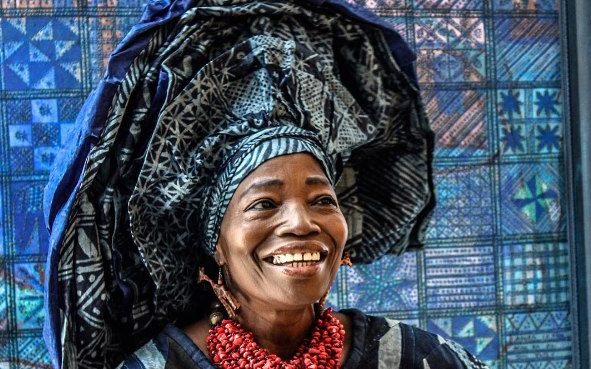Textile artist Nike Davies-Okundaye worked as a construction laborer and carried water and firewood to survive. The art of adire gave her global fame and she is now educating generations of women in Nigeria.
There was no way Nike Davies-Okundaye could look the other way. For after all, she too had been a victim in her early teens.
Too many women were being pushed down the traditional path of marriage and child-rearing in her country.
Born in 1951 in Ogidi-Ijumu, a small village in western Nigeria known for its spectacular rock formations and traditional art industry, Davies-Okundaye resolved to fight this practice four decades ago.
“By the age of 13, they wanted to marry me off because my father had no money. I had to run away from home and join a traveling theater. I said I didn’t want to marry and wanted to pursue art,” recalls the internationally-renowned Lagos-based artist.
Loading...
Not wanting to become one of six wives to a minister, Davies-Okundaye found her escape through adire, the name given to the Yoruba craft of tie-and-dye where indigo-dyed cloth is made using a variety of resist-dyeing techniques. Growing up in a predominantly art and craft household, Davies-Okundaye is a fifth-generation artist who decided to take the craft seriously due to poverty.
“I had no money to go to school and the first education parents give you is to teach you what they do. So, when I finished primary six and I had no support to go to secondary school, I said to myself, ‘let me master art so I can teach other women to also use their hand to make a living through their own artwork’.”
Davies-Okundaye was forced to work in the male-dominated construction sector, carrying concrete in pans to builders in order to save one shilling, just enough to buy a yard of fabric to create what she called wall-hanging art.
Her goal was to use the traditional wax-resist methods to design patterned fabric in a dazzling array of tints and hues. The adire design is the result of hand-painted work carried out mostly by women and through that, Davies-Okundaye saw a way to help women to become economically empowered. After all, her first break in life came as a result of that.
“There was no other job I was doing apart from adire. I was lucky the American government came to Nigeria to recruit an African who will teach African Americans how to make traditional textiles or crafts in the state. That is how I was lucky and got picked.”
Davies-Okundaye was the only woman in a class of 10 men who were flown to Maine in northeastern United States in 1974. That is where her whole outlook on life changed.
“Before I went to America, I used to carry three drums of water every day and carry firewood to be able to survive. It was like a breakthrough in my life when I reached America. I said ‘is this heaven?’ I was the only woman in the class and all the men were learning women’s looms and I kept telling them ‘this is for women’ and they said ‘yes, in America, what a man can do, a woman can also do’.”
This was in stark contrast to what she knew to be true in Nigeria at the time.
“If your husband is an artist, you are not allowed to do art. In the 1960s, if your husband has a PhD, you are not allowed to also have a PhD. You had to give room for your husband to be your boss.”
She decided to beat those age-old stereotypes.
As one of 15 wives to her then-husband at the time, Davies-Okundaye, with her newfound knowledge gained in America, started a revolution at home. She encouraged the other wives to create their own art business using adire.
“I said ‘if you learn this, you can earn a living by yourself and get your power because your money is your power’ and that is how they also started learning it. I didn’t stop sharing the knowledge there. I gathered girls on the streets who were selling kola nuts and peanuts and started training them. I said ‘if this textile can take me to America, let me teach other people’,” says Davies-Okundaye.
And that has been her calling ever since. Davies-Okundaye is the founder and director of four art centers, which offer free training to 150 young artists in Nigeria in visual, musical and performing arts.
One of the centers is the largest art gallery in West Africa comprising over 7,000 art works.
“They used to get the police to arrest me because they said I was trying to teach feminism in Nigeria because I went to America. They said I was going to corrupt our Nigerian women but I believe God sent me to liberate a lot of women who have the passion for what makes them happy but are afraid to do it because of what people will say. I say do what makes you happy always!”
Loading...
